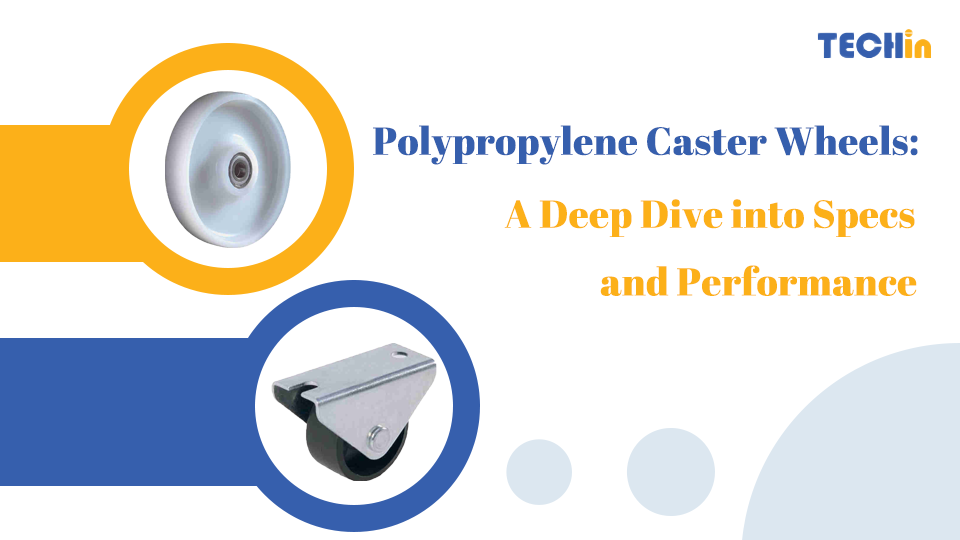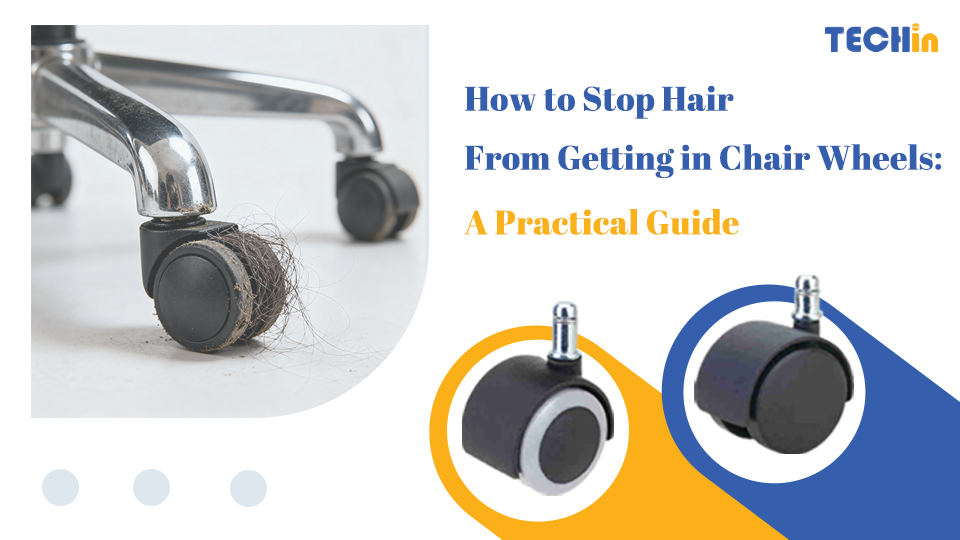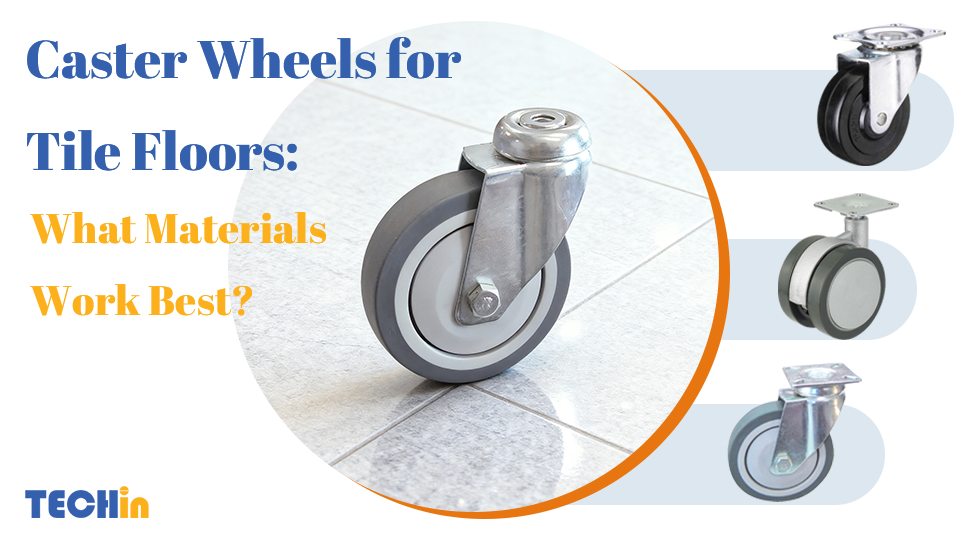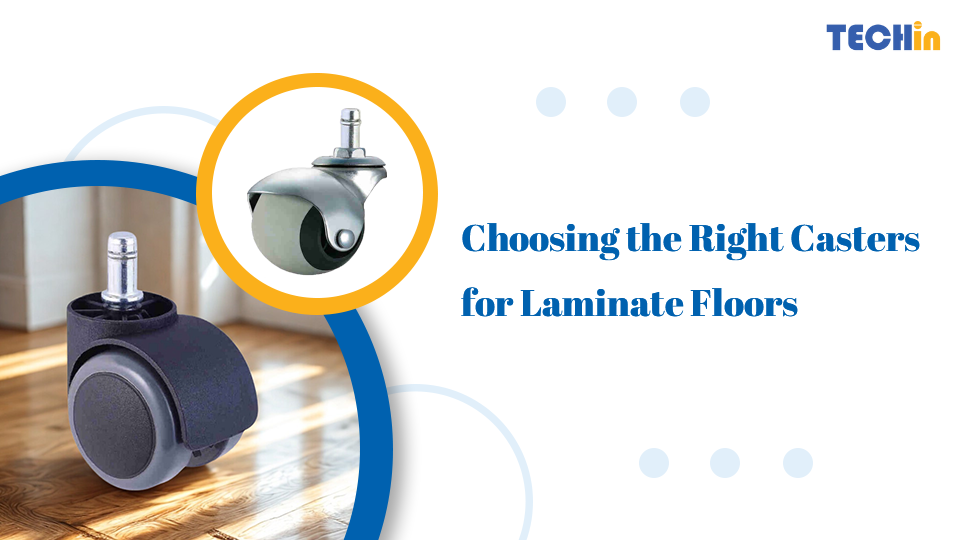Are you having trouble finding the perfect caster wheels for your needs? Whether you’re putting new wheels on furniture, upgrading industrial equipment, or just replacing worn-out wheels, it can be overwhelming to understand the different types, materials, and applications of caster wheels. This guide will walk you through everything you need to know about caster wheels so you can make an informed decision and choose the right caster wheels with confidence.
Caster wheels are crucial for mobility in a variety of applications, from furniture and equipment to industrial and heavy-duty uses. Understanding the anatomy, types, materials, load capacity, mount types, bearings, and size measurements will help you select the perfect caster wheels for your specific needs.
Let’s dive into the details to find out how to choose the right caster wheels.
What are Caster Wheels?
Caster wheels are pivoting wheels attached to the bottom of furniture or portable equipment, allowing for easy movement. They are essential in many settings, providing mobility and enhancing the functionality of the equipment they are attached to. You can find casters in many applications, from office chairs and medical equipment to industrial machinery and heavy-duty carts.
Anatomy of Casters
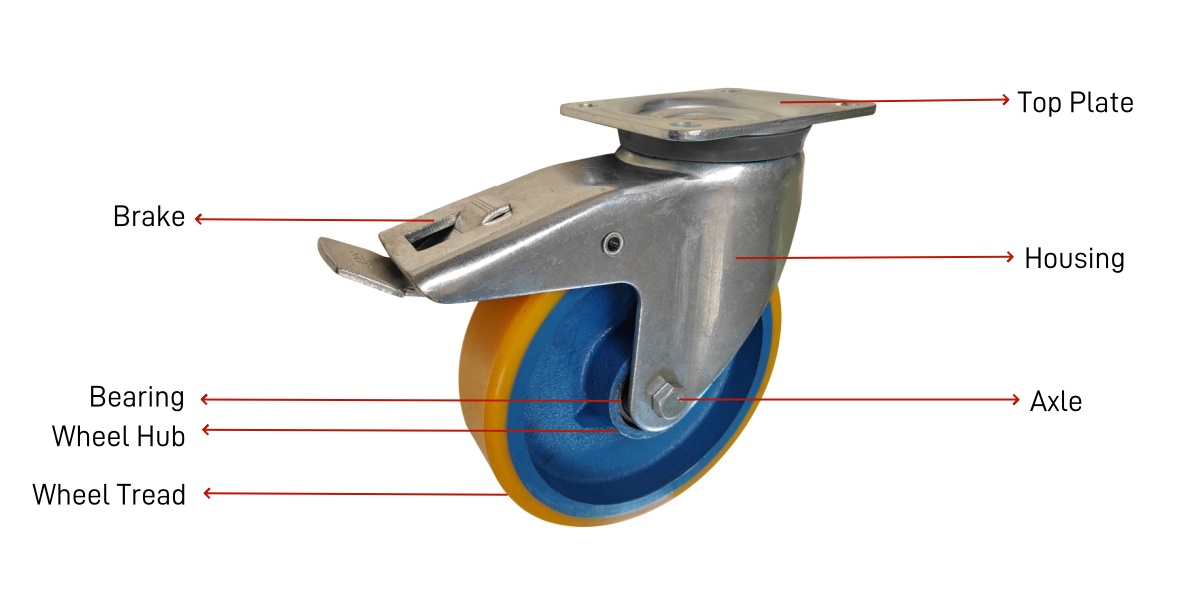
Understanding the anatomy of casters helps you select the right type. A basic caster consists of the following components, each serving a specific purpose:
- Wheel: The part that rolls on the ground, providing mobility.
- Housing: The framework that holds the wheel and connects it to the mounting component.
- Top Plate: The part that attaches the caster to the equipment. a flat metal plate with holes at each corner to attach the caster securely to the bottom of an object.
- Bolt Hole: Single hole for a bolt or screw. Quick to attach, ideal for smaller, lighter furniture and equipment.
- Threaded Stem: A rod (threaded, grip ring, or expanding) inserted into a hole for easy mounting on narrow frames. Common in chairs, medical devices, and light furniture.
- Stem: A cylindrical mounting option that fits into a socket in the equipment.
- Brake: Mechanisms to stop the wheel. Includes dual brake (locks both wheel and swivel) and side brake (locks only the wheel).
- Bearing: Ensures smooth rolling of the wheel, reducing friction and wear.
- Wheel Tread: The outer surface of the wheel that contacts the ground, affecting traction and durability.
- Wheel Hub: The central part of the wheel around which it rotates, housing the bearings.
- Axle: The rod that passes through the hub, allowing the wheel to rotate.
Here’s a table summarizing the components and their functions:
| Component | Function |
|---|---|
| Wheel | Provides mobility by rolling on the ground |
| Housing | Holds the wheel and connects it to the mounting component |
| Top Plate/Stem/Bolt Hole | Attaches the caster to the equipment |
| Bolt Hole | Allows a bolt to secure the caster |
| Stem | Fits into a socket in the equipment |
| Brake | Stops the wheel; includes dual brake and side brake |
| Bearing | Ensures smooth rolling, reduces friction and wear |
| Tread | Contacts the ground, affects traction and durability |
| Hub | Central part of the wheel, houses the bearings |
| Axle | Allows the wheel to rotate |
Types of Caster Wheels

Caster wheels come in various types, each suited for specific applications:
- Fixed Casters: These casters only move in a straight line and are ideal for applications requiring linear movement.
- Swivel Casters: These casters can rotate 360 degrees, providing excellent maneuverability for navigating tight spaces.
- Braked Casters: These casters come with a braking mechanism to lock the wheel in place, adding stability when needed.
| Type | Description |
|---|---|
| Fixed Casters | Move in a straight line, ideal for linear movement |
| Swivel Casters | Rotate 360 degrees for excellent maneuverability |
| Braked Casters | Include a braking mechanism for added stability |
Applications of Caster Wheels
Caster wheels are used in a wide range of applications, each requiring specific features and capabilities:
- Furniture Casters: Used in chairs, tables, and cabinets for easy repositioning.
- Apparatus Casters: Found in medical equipment and laboratory apparatus where mobility and stability are crucial.
- Industrial Casters: Used in factories and warehouses for heavy machinery and equipment, often designed for high load capacities.
- Heavy Duty Casters: Designed to carry very heavy loads, often used in industrial settings for large equipment and heavy carts.
- Garbage Bin Casters: Specifically designed for waste management bins, providing easy movement even when fully loaded.
| Application | Description |
|---|---|
| Furniture Casters | Used in chairs, tables, and cabinets |
| Apparatus Casters | Found in medical equipment and laboratory apparatus |
| Industrial Casters | Used in factories and warehouses |
| Heavy Duty Casters | Designed for very heavy loads |
| Garbage Bin Casters | Designed for waste management bins |
Materials Used in Caster Wheels
Caster wheels can be made from various materials, each offering distinct advantages:
- Rubber: Offers a smooth ride and is good for indoor applications.
- Polyurethane: Durable and resistant to chemicals, suitable for industrial use.
- Nylon: Lightweight and cost-effective, ideal for light-duty applications.
- Aluminum: Strong and corrosion-resistant, used in heavy-duty settings.
- Pneumatic: Air-filled tires providing cushioning, perfect for rough terrain.
- Foam: Lightweight and shock-absorbing, often used in quieter applications.
- Cast Iron: Extremely durable and able to withstand high temperatures, suitable for harsh environments.
- Forged Steel: Offers the highest load capacity and durability, ideal for heavy industrial use.
| Material | Characteristics |
|---|---|
| Rubber | Smooth ride, good for indoor use |
| Polyurethane | Durable, chemical resistant, industrial use |
| Nylon | Lightweight, cost-effective, light-duty |
| Aluminum | Strong, corrosion-resistant, heavy-duty |
| Pneumatic | Air-filled, cushioning, rough terrain |
| Foam | Lightweight, shock-absorbing |
| Cast Iron | Extremely durable, high-temperature resistant |
| Forged Steel | Highest load capacity, highly durable |
Determining Caster Load Capacity
Determining the load capacity of your caster wheels is crucial for ensuring safety and functionality. Here’s a detailed approach to calculating the appropriate load capacity for your casters:
- Calculate the Total Load: Determine the total weight of the equipment, including the maximum load it will carry. This includes the weight of the equipment itself plus any additional load it will be handling.
- Divide by the Number of Casters: Divide the total load by the number of casters to find the load capacity per caster. For example, if the total load is 500 kg and there are four casters, each caster should support at least 125 kg.
- Add a Safety Margin: It’s essential to add a safety margin to account for uneven weight distribution and dynamic loads (such as sudden movements or impacts). A common practice is to add a 25-30% safety margin. In our example, multiplying 125 kg by 1.25 gives a required capacity of approximately 156 kg per caster.
- Consider the Application: Different applications might have different requirements. For example, casters used in an industrial setting with frequent heavy loads and rough terrain will need a higher safety margin compared to casters used in a stable indoor environment.
- Check Manufacturer Specifications: Always refer to the manufacturer’s specifications for the casters. They often provide detailed load capacity information based on their testing and safety standards.
Types of Caster Mounts
Casters can be mounted in various ways, depending on the application and space available:
- Plate Mounts: Provide a large surface area for secure attachment, ideal for heavy-duty applications.
- Stem Mounts: Used for applications with limited mounting space, such as chairs and small carts.
- Bolt Hole Mounts: Allow for a secure attachment using bolts through a central hole, often used in medium to heavy-duty applications.
| Mount Type | Description |
|---|---|
| Plate Mounts | Large surface area for secure attachment |
| Stem Mounts | Used for limited mounting space |
| Bolt Hole Mounts | Secure attachment using bolts through a central hole |
Bearing Types in Caster Wheels
Bearings are crucial for the smooth operation of caster wheels, reducing friction and wear:
- Roller Bearing: Suitable for heavy loads, offering smooth operation and longevity.
- Plain Bearing: Simple and cost-effective, ideal for light-duty applications where speed and smoothness are less critical.
- Single Ball Bearing: Provides a balance of cost and performance, suitable for medium-duty applications.
- Double Ball Bearing: Offers superior performance and longevity, ideal for demanding applications where smooth movement is essential.
| Bearing Type | Description |
|---|---|
| Roller Bearing | Suitable for heavy loads, smooth operation |
| Plain Bearing | Simple, cost-effective, light-duty |
| Single Ball Bearing | Balance of cost and performance |
| Double Ball Bearing | Superior performance, ideal for demanding applications |
How to Measure Caster Size
Accurate measurements ensure the casters will fit and function correctly:
- Wheel Diameter: Measure the distance across the wheel to determine its size.
- Wheel Width: Measure the width of the wheel’s contact surface to ensure stability and load distribution.
- Overall Height: Measure from the bottom of the wheel to the top of the mounting plate or stem, which affects the equipment’s height.
- Axle Hole: Measure the diameter of the hole where the axle passes through to ensure compatibility with your equipment.
- Hub Length: Measure the width of the wheel hub, which houses the bearings and axle.
- Top Plate Size: Measure the dimensions of the top mounting plate for proper fitting.
- Mounting Hole Center: Measure the distance between the centers of the mounting holes to align with the equipment.
- Mounting Hole Size: Measure the diameter of the mounting holes to ensure the bolts fit securely.
- Offset: Measure the distance between the wheel’s centerline and the mounting plate, affecting the caster’s swivel radius and maneuverability. Proper offset measurement ensures that the caster can rotate freely without obstruction.
- Bolt Hole Size: Measure the diameter of the bolt holes used for mounting the caster to ensure compatibility with the bolts or screws you will use. Accurate bolt hole sizing is crucial for secure and stable attachment.
| Measurement | Description |
|---|---|
| Wheel Diameter | Distance across the wheel |
| Wheel Width | Width of the wheel’s contact surface |
| Overall Height | From the bottom of the wheel to the top of the mounting plate or stem |
| Axle Hole | Diameter of the hole where the axle passes through |
| Hub Length | Width of the wheel hub |
| Top Plate Size | Dimensions of the top mounting plate |
| Mounting Hole Center | Distance between the centers of the mounting holes |
| Mounting Hole Size | Diameter of the mounting holes |
| Offset | Distance between the wheel’s centerline and the mounting plate, affecting swivel radius |
| Bolt Hole Size | Diameter of the bolt holes used for mounting |
Summary
Now that you have a complete understanding of caster wheels, including their anatomy, types, applications, materials, load capacities, mount types, bearings, and how to measure them, you can confidently choose the right casters for your needs. Whether you’re putting new wheels on furniture, upgrading industrial equipment, or replacing worn-out wheels, this guide equips you with the knowledge to make an informed decision. If you have any questions or need further assistance, feel free to reach out.



